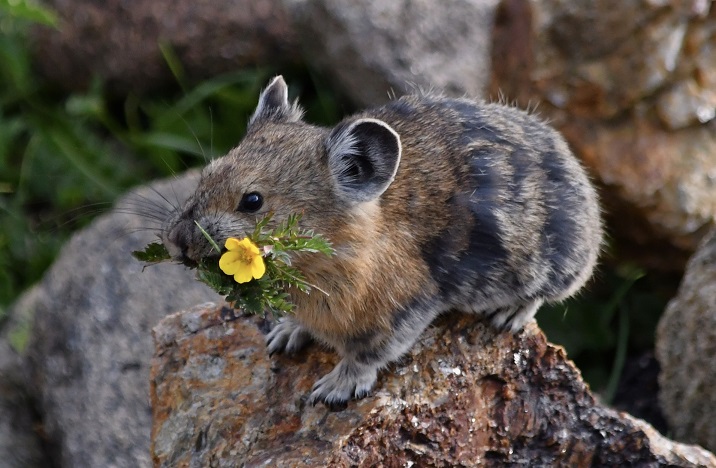
Pikas are a small, short-legged and tailless mammals that can be found in the mountains of western North America and in much of the steppes of Asia and eastern Europe. Despite their small size, body shape, and round ears, pikas are not rodents but are actually closest related to hares and rabbits.
What does a pika look like?
Pikas are small mammals, with short limbs and rounded ears. They are about 15 to 23 centimeters (5.9 to 9.1 in) in body length and weigh between 120 and 350 grams (4.2 and 12.3 oz), depending on species. Pikas are remarkably uniform in body proportions. Their fur is long and soft and is grayish-brown, although a few species are rusty red. Unlike rabbits and hares, the hind limbs are not longer than their forelimbs.
Rock-dwelling pikas have small litters of fewer than five young, while the burrowing species tend to give birth to more young and to breed more frequently, possibly due to greater availability of resources in their native habitats.
Where do pikas live?
Pikas are native to cold climates, mostly in Asia, North America, and parts of Eastern Europe. Most species live on rocky mountainsides, where there are many crevices in the rocks for them to shelter in. Some pikas that are native to open steppe lands also construct crude burrows for shelter. In the mountains of Eurasia, pikas often share their burrows with snow finches.
Pikas require cold temperatures to survive and can die if exposed to temperatures above 77.9 °F or 25.5 °C. If temperatures rise too high, some pika populations are forced to restrict their ranges to even higher elevations.
When are pikas active?
Pikas can be found active during all time of daylight and through the late evening, with higher-elevation species generally being more active during the daytime. They show their peak activity just before winter. Since pikas don’t hibernate, they spend a lot of time during the summer collecting and storing food they will eat over the winter.
The rock-dwelling species of pika will store its own “haypile” of dried vegetation, while burrowing species often share food stores with their burrow mates. Haying behavior is more prominent at higher elevations, where pikas live a more solitary lifestyle. Many of the vocalizations and social behaviors that pikas exhibit are related to haypile defense.
Eurasian pikas commonly live in family groups and share duties of gathering food and keeping watch. Some species are territorial. North American pikas are asocial, leading solitary lives outside the breeding season.
What does a pika sound like?
Pikas have a distinct sound that vary in duration. The call can either be short and quick, a little longer and more drawn out, or they can be songs. The pikas determine the appropriate time to make short calls by listening for cues for sound localization.
The calls are used for individual recognition, predator warning signals, territory defense, or to attract a mate. There are also different calls depending on the season. In the spring, the songs become more frequent during the breeding season. In late summer, the vocalizations become short calls.
What is a pika’s diet?
The pika is a generalist herbivore, and feeds on a wide variety of green plants, including forbs, grasses, sedges, shrub twigs, moss, lichen, different grasses, sedges, thistles, and fireweed. As with other lagomorphs, pikas have gnawing incisors and no canines, although they have fewer molars than rabbits.
Like rabbits, after eating they initially produce soft green feces, which they eat again to take in further nutrition, before producing the final, solid, fecal pellets. Although pikas can meet their water demands from the vegetation they eat, they drink water if it is available in their environment.
